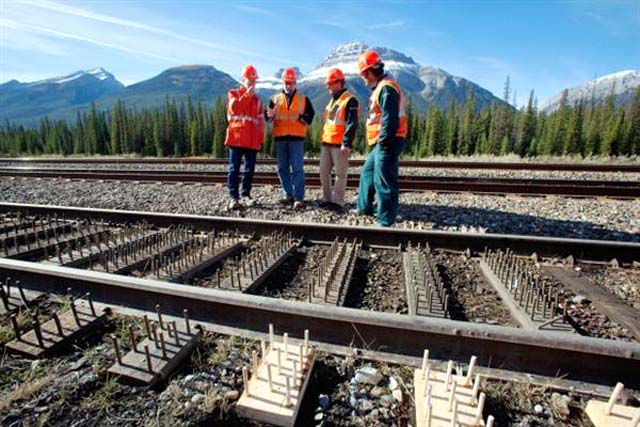
2011
|


From left, Chris Bunce with Canadian Pacific Environment Programs, Fred Green CP CEO, stand with Banff National Park
CEO Alan Latourelle, and warden and bear specialist Bill Hunt at the test site for various bear conflict mitigation devices along the Canadian Pacific line
west of Banff.
30 September 2011
Railway Tests Innovative Ways to Prevent Hitting Banff Grizzly Bears
Banff Alberta - Researchers know bears caught unawares on railway tracks try to run from oncoming trains. The problem is, they run in
the wrong direction.
Now, with the help of wooden pegs and electric mats, Parks Canada is trying to encourage the creatures to veer out of the way before they get hit.
Attracted to the open corridors carved by the rail lines that snake through the mountain parks, an average of between one and two grizzly bears die per year in
Banff National Park.
Earlier this year, a mother bear was caught on the track near Lake Louise. She ran directly into the train's path, orphaning two cubs.
It's deaths like these that prompted Canadian Pacific Railway to donate $1 million toward research to prevent bear fatalities on the rails. The company, in
conjunction with Parks Canada, held a symposium in Banff on Thursday to gather ideas from researchers.
So far, early research has shown bears do know to run away from trains, but rather than dart off into the bush, they tend to hurtle forward into the open path
ahead, inadvertently staying in the line of the oncoming locomotive.
So Bill Hunt, resource conservation manager for the park, demonstrated one possible solution: wooden peg boards screwed to the railway sleeper.
Hunt said the pegs, laid at intervals of 100 metres, may encourage bears to veer out of the way.
"It seems silly that a bear can be taken by surprise by a train, but it happens to people, it happens to bears," he said.
The number of deaths may seem few, but Banff's bear population is so precarious that even one or two accidents could determine the long-term survival of the
species in the park.
Banff has about 60 grizzly bears, Hunt said. If the park loses many more, grizzlies may not be able to sustain their numbers.
Railways are now one of the leading human causes of bear deaths.
Hunt said fencing off the railroad, as the park has done for the nearby Trans-Canada Highway, is a possibility. But the lines are major corridors for
travelling animals.
"That would restrict movement for all other wildlife," he said.
And unlike a frequently used highway, a track is bereft of traffic most of the time, which means bears may wander into a fenced area and become trapped in
front of an oncoming train.
To mitigate that risk, the CPR is also testing an electrified mat that would act like a cattle gate. The shock-delivering black and yellow board would allow
trains to pass but, hopefully, discourage animals from travelling the track.
Both the pegs and the mats are being set up in high-risk sections of the track where bears have died in the past. There, cameras will record the animals'
activity to see if the methods change bear behaviour.
Fred Green, the president and CEO of Canadian Pacific Railway, said the railway and park have fixed the most obvious problems, such as inadequate garbage
disposal. Now, they have to turn to more sophisticated solutions.
"We need to turn our minds collectively, everyone involved, to looking to different innovative and alternative strategies because those which we've used,
well, they've been better than the past, but they're not good enough because we're still having bear mortality events," he said.
With more scientific research, the company hopes to find practical methods to keep bears away from trains.
If successful, the tactics could be used in other regions facing similar problems.
"I think it's a challenge for society. These are iconic species that must be preserved," Green said.
On average, train conductors spot about 100 bears per year on the tracks that run through the mountain parks. In the past year, the railway company has tried
to collect more information about non-fatal and near-miss sightings.
Bears have long been attracted to railway tracks. They offer a clear path through thick forest. In addition, old rail cars often let grain slip onto the
ground.
Although most federal cars have since been retrofitted, bears can still be seen digging through the gravel ballast, looking for food. It may take several
generations before the bruins are rid of the habit.
"We've made a lot of effort to reduce the grain spillage in the area.
"We've spent $20 million retrofitting grain cars to reduce the potential for grain spills," said Chris Bunce, general manager of environment and
safety programs with Canadian Pacific. "We have an intensive grain cleanup system in the area. We have vacuum trucks and specific infrastructure."
Other tactics the park is considering include installing more noisemakers and burning sections of scrub away from the track to create bear-friendly habitats
further from the tracks.
Jen Gerson.

|
